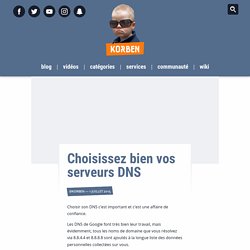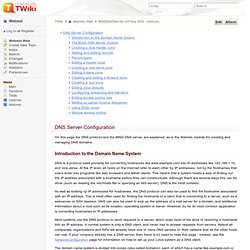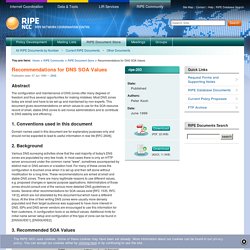

Le DNS pour les débutants.
DNS Over HTTPS (DOH) Namecoin. Choisissez bien vos serveurs DNS – Korben. Choisir son DNS c’est important et c’est une affaire de confiance.

Les DNS de Google font très bien leur travail, mais évidemment, tous les noms de domaine que vous résolvez via 8.8.4.4 et 8.8.8.8 sont ajoutés à la longue liste des données personnelles collectées sur vous. Les DNS de votre FAI ne sont à priori pas utilisés pour vous profiler, par contre, ils sont maintenant censurés arbitrairement par certaines autorités administratives françaises. Il est donc difficile de leur faire confiance. Les DNS des bornes Wifi ou de certains fournisseurs de DNS gratuits sont utilisés aussi comme collecteurs de données et sont les 3/4 du temps des DNS menteurs car ils ne vous envoient pas vers les véritables sites, mais vers des versions modifiées intégrants de la publicité ou d’autres trackers plus ou moins discrets.
Alors que nous reste-t-il niveau DNS ? Source. Nsupdate.info. Pourquoi « Le Monde » a-t-il brutalement disparu d'Internet vendredi matin ? Vendredi matin, le site web du quotidien Le Monde a été inaccessible durant quelques heures.

La cause de cette défaillance ? Un changement d'hébergeur DNS mal maîtrisé. En début de matinée vendredi 11, les internautes français qui ont voulu consulter le site web du quotidien le Monde ont eu la surprise de constater qu'il était totalement inaccessible. Aussitôt l'incident signalé sur Twitter, les hypothèses les plus farfelues sont évoquées : non-paiement du nom de domaine lemonde.fr, comme c'était arrivé à TF1 pour son site de vidéos Wat TV ? Test grandeur nature des effets de la loi LOPPSI 2 ?
Rien de tout cela, l'explication est technico-administrative : Le Monde a changé de bureau d'enregistrement et d'hébergeur pour ses DNS, et ce changement a été mal maîtrisé. Comment fonctionne le DNS ? Le DNS est basé sur un système arborescent hiérarchique : une racine unique, symboliquement dénommée " (source Wikipedia) (source Wikipedia) Que s'est il passé vendredi matin ? Que faire en pareil cas ? Comment fonctionne le DNS ? DNSSEC HOWTO. Olaf Kolkman Revision 134 July 4,2009 About This Document This HOWTO is not a HOWTO.

In 2000-2001 this document started ts life as an addendum to a DNSSEC course I organized at the RIPE NCC but in cause of time it has grown beyond the size of your typical HOWTO and became a (hopefully) comprehensive tutorial on the subject of DNSSEC and DNSSEC deployment. This HOWTO is intended for those people who want to deploy DNSSEC and are seeking a document that lives between a typical high level description of the topic (see the excellent Surfnet White Paper on DNSSEC for that ( ), the typical out of the box recipe, and an in depth description of the technology.
I this tutorial we touch upon the following topics: Part I, intends to provide some background for those who want to deploy DNSSEC. Part II, about the aspects of DNSSEC that deal with data security. Part III, describes a few tools that may turn out handy while figuring out what might have gone wrong. BINDDNSServer. On this page the DNS protocol and the BIND DNS server are explained, as is the Webmin module for creating and managing DNS domains.

Introduction to the Domain Name System DNS is a protocol used primarily for converting hostnames like www.example.com into IP addresses like 192.168.1.10, and vice-versa. At the IP level, all hosts on the Internet refer to each other by IP addresses, not by the hostnames that users enter into programs like web browsers and telnet clients. This means that a system needs a way of finding out the IP address associated with a hostname before they can communicate. Although there are several ways this can be done (such as reading the /etc/hosts file or querying an NIS server), DNS is the most common. As well as looking up IP addresses for hostnames, the DNS protocol can also be used to find the hostname associated with an IP address. The domain name system is divided into zones (also called domains), each of which has a name like example.com or foo.com.au.
Recommendations for DNS SOA Values. Abstract The configuration and maintainance of DNS zones offer many degrees of freedom and thus several opportunities for making mistakes.

Most DNS zones today are small and have to be set up and maintained by non-experts. This document gives recommendations on which values to use for the SOA resource record of small, stable DNS zones to aid novice administrators and to contribute to DNS stability and efficiency. 1. Conventions used in this document Domain names used in this document are for explanatory purposes only and should not be expected to lead to useful information in real life [RFC 2606]. DNSMON — RIPE Network Coordination Centre. Cours dns cnam SHOW.